The Musawwarat Graffiti Project Database
The project database, which was developed for the Musawwarat Graffiti Project and which the web-based 'Graffiti in Place Database' of the Musawwarat Graffiti Archive draws from, was created using Filemaker. This proprietary database management system was chosen over Open Source software for a number of reasons. Firstly, its graphic user interface can be easily designed in a way that permits intuitive use by a range of 'handlers', most of whom lack IT knowledge. Secondly, smaller changes to the database can be made by the users themselves without needing IT support. Thirdly, for working with the Musawwarat graffiti corpus, a database system was needed that would allow embedding large numbers of images into the database easily, rather than just linking externally stored image files to it. As it is used for data entry in the field as well as in the lab, the research database was designed to be easy to migrate from one system to another, and it is potentially accessible from several work stations at once.
The main task of the project database is the documentation and archiving of the photographs taken on site during several field seasons together with the respective metadata such as picture size, authorship, and the pictured wall (or wall section), block or block group, or graffito and graffiti group. In a second step, the database contains a system for recording both formalised and unrestricted descriptions of various aspects of the graffiti of Musawwarat, as well as of comparative and archival data. Through this it is also a tool for the scientific evaluation of the graffiti and the site. Furthermore, the research database provides an interface for publishing the collected data through the web-based 'Graffiti in Place Database'.
During the development of the database, a number of challenges arose: the photographs, although belonging to the same class of media, portray different kinds of information (mostly depending on the scope and the scale of the photograph). Photographs can refer to graffiti entities or graffiti groups, or architectural entities, which can be either very detailed (individual blocks) or are meant to provide an overview (wall and section photos). All the relevant metadata have to be collected and connected to these different sets of information. For this, the different kinds of architectural and graffiti entities are all defined as datasets in separate tables. As one block can contain several graffiti, and one graffito can spread over several blocks, the core relation between our data is designed as a typical n:m relationship, which makes the structure of the research database rather complex.
Text: Elisabeth Lindinger (2012)







